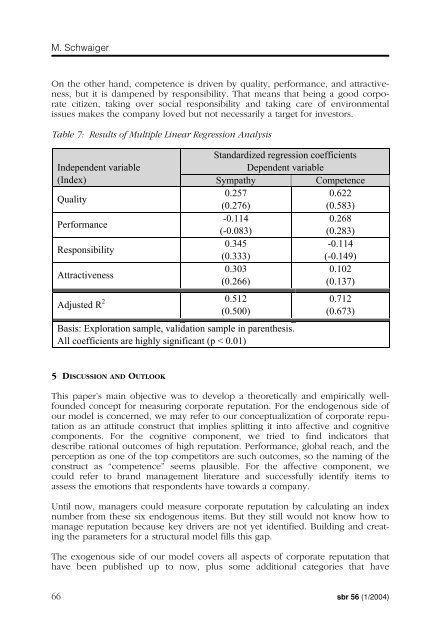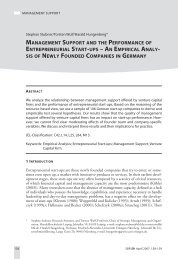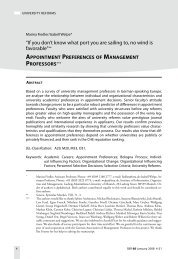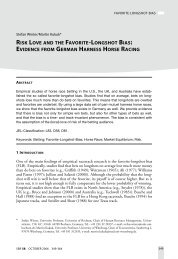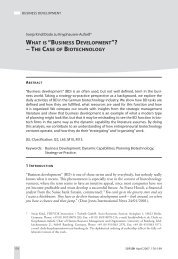components and parameters of corporate reputation - sbr ...
components and parameters of corporate reputation - sbr ...
components and parameters of corporate reputation - sbr ...
Create successful ePaper yourself
Turn your PDF publications into a flip-book with our unique Google optimized e-Paper software.
M. Schwaiger<br />
On the other h<strong>and</strong>, competence is driven by quality, performance, <strong>and</strong> attractiveness,<br />
but it is dampened by responsibility. That means that being a good <strong>corporate</strong><br />
citizen, taking over social responsibility <strong>and</strong> taking care <strong>of</strong> environmental<br />
issues makes the company loved but not necessarily a target for investors.<br />
Table 7: Results <strong>of</strong> Multiple Linear Regression Analysis<br />
���������������������<br />
��������������������������������������<br />
�������������������<br />
�������� ��������� �����������<br />
��������<br />
������<br />
��������<br />
������<br />
��������<br />
������������<br />
�������<br />
���������<br />
������<br />
��������<br />
���������������<br />
������<br />
��������<br />
�������<br />
���������<br />
���������������<br />
������<br />
��������<br />
������<br />
��������<br />
���������� � �<br />
������<br />
��������<br />
��������������������������������������������������������������<br />
���������������������������������������������������<br />
5 DISCUSSION AND OUTLOOK<br />
������<br />
��������<br />
This paper’s main objective was to develop a theoretically <strong>and</strong> empirically wellfounded<br />
concept for measuring <strong>corporate</strong> <strong>reputation</strong>. For the endogenous side <strong>of</strong><br />
our model is concerned, we may refer to our conceptualization <strong>of</strong> <strong>corporate</strong> <strong>reputation</strong><br />
as an attitude construct that implies splitting it into affective <strong>and</strong> cognitive<br />
<strong>components</strong>. For the cognitive component, we tried to find indicators that<br />
describe rational outcomes <strong>of</strong> high <strong>reputation</strong>. Performance, global reach, <strong>and</strong> the<br />
perception as one <strong>of</strong> the top competitors are such outcomes, so the naming <strong>of</strong> the<br />
construct as “competence” seems plausible. For the affective component, we<br />
could refer to br<strong>and</strong> management literature <strong>and</strong> successfully identify items to<br />
assess the emotions that respondents have towards a company.<br />
Until now, managers could measure <strong>corporate</strong> <strong>reputation</strong> by calculating an index<br />
number from these six endogenous items. But they still would not know how to<br />
manage <strong>reputation</strong> because key drivers are not yet identified. Building <strong>and</strong> creating<br />
the <strong>parameters</strong> for a structural model fills this gap.<br />
The exogenous side <strong>of</strong> our model covers all aspects <strong>of</strong> <strong>corporate</strong> <strong>reputation</strong> that<br />
have been published up to now, plus some additional categories that have<br />
66 <strong>sbr</strong> 56 (1/2004)


